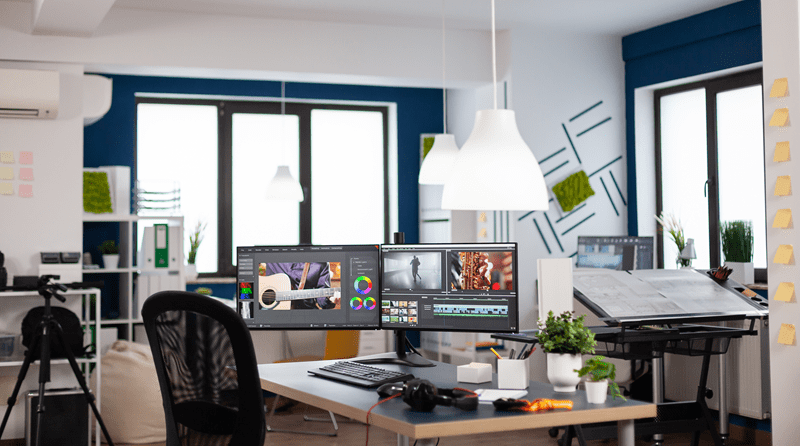
What started as a luxury is turning out to be an indispensable part of the modern workspace: dual-monitor setups in today's fast-paced digital work environment. The use of dual monitors can definitely help a designer, coder, video editor, gamer, and remote worker substantially improve workflow and efficiency by offering better comfort. If you want to really take full advantage of the benefits, your setup needs to be thoughtfully planned; it's not just about placing two screens side by side.
Here we will take you through productivity tips you should know to assemble the ultimate dual monitor setup that will maximize your productivity and comfort level. Every nuance, from screen extension configuration to cable management and display calibration, counts, along with ergonomic viewing, to increase comfort while working throughout the day.
There's a pretty clear productivity benefit with two monitors: several studies, including one from the University of Utah, report that users on dual screens can finish tasks 20-30% faster compared to single-monitor users. The reason is fairly obvious: you can multitask more naturally.
It saves time by keeping you focused and not letting workflow disruptions get in the way. Be it spreadsheet management, video editing, coding, or report writing, any professional job done on an extended workspace will provide better visualization of information, hence allowing quicker and smarter decision-making.
Setting up a dual-monitor rig isn't quite as straightforward as just hooking up an additional screen-at least, it isn't if you're looking to optimize for comfort and performance. Here's how to approach your setup in a strategic way.
Although different brands and sizes can be utilized, the ultimate configuration for a dual monitor would include matching monitors in order to ensure that consistency is attained in the experience.
If you already have one, then try finding a second one with similar display specifications so that the colors and brightness are matched to each other as closely as possible.
Here are three common ways dual monitors are set up:
That depends upon desk space and workflow needs.
This should be a sturdy desk, deep enough to fit both screens on it comfortably and also leave room for peripherals. The monitor arms will free up surface space, improve cable management, and then the monitors can tilt, swivel, or rotate for ergonomic viewing to minimize neck and shoulder strain.

Comfort directly relates to productivity. A misplaced monitor will only contribute to eye fatigue and neck stiffness, culminating in posture problems. For good viewing ergonomics, consider the following adjustments:
This ergonomic chair, combined with the adjustable arm and dual-monitor setup, can keep one very comfortable and able to focus for long stretches.
The best workspace can look messy due to a big jumble of wires. Good cable management keeps things neat and distraction-free.
The following are a few simple ways:
Cleaning up the cable management enhances the aesthetic look of the place, apart from helping to prevent accidental disconnections and tripping hazards. Therefore, this may keep your dual-monitor setup both efficient and safe.
The magic of a dual-monitor setup is in screen extension: your operating system lets you treat both screens as one large workspace.
How to Set It Up:
Once set up, you are able to drag your windows freely between them. The typical example would be a video editor who places the editing timeline on one screen and the preview on another. Some writers open research on one monitor and draft on the main; designers often do the same thing with references opened for comparison.
Experiment with the arrangement until the screen extension feels intuitive to you and supports your workflow.
Brightness, contrast, and color accuracy discrepancies usually make two screens in one workspace distracting and disruptively affect creative work. Calibration ensures that both monitors show consistent visuals.
Here is how it's done:
Well-executed display calibration will not only make your work look better but also prevent eye strain, which may be brought about by uneven lighting across your dual-monitor setup.
Now that you have the setup ready, it is time to make the most of it. Here are some expert productivity tips to help you work smarter and not harder. Define your screen roles now by declaring what each monitor is used for. You will use the main screen to work on central tasks, and the secondary screen will be used for communication applications, notes, or references.
Take breaks for your eyes using the 20-20-20 rule, whereby every 20 minutes, look away 20 feet for 20 seconds to avoid eye strain. These productivity tips will make a dual-monitor setup not just about having more screen space but smarter utilization of space.
As technology changes in leaps and bounds, it is prudent that you choose hardware and accessories that change with it.
Look for:
Invest in good gear so that even if your needs at work grow, your dual-monitor setup will be relevant.
A well-planned dual monitor setup is doubtless one of the easiest and most effective upgrades you can make to your workspace. It makes workflow easier and reduces stress, plus increases comfort, but only if it has been planned out with intention. You had been surviving on just one screen; let this be your sign that it is time to expand your digital horizon. These productivity tips and setups are going to make the working space so much more efficient and fun; technology is finally going to work with you, not against you.
This content was created by AI